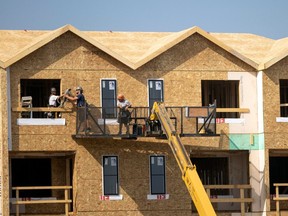[ad_1]
In Saskatchewan, the First Nations population has doubled since the year 2000 and is destined to double again by the year 2040.

Article content
First Nations infrastructure is woefully inadequate according to a report released by the Assembly of First Nations. The report says the government will require $350 billion to close the gap by the target year of 2030.
The research for the report was done by the AFN along with support from Indigenous Services Canada and it reveals that First Nations continue to have a shortage and, in some cases, a lack of infrastructure support.
Advertisement 2
Article content
Article content
Infrastructure refers to public buildings and services such as schools, social services including childcare, elders care and clinics. Also, roads, power lines, sewer systems and safe water, to name some examples.
Today, there are 31 First Nations communities that continue to live under water drinking advisories. The housing shortfall nationally sits at approximately $135 billion.
To bring Indigenous infrastructure in line with the rest of the country would require an additional $135 billion for housing. On top of that, according to the report, an additional $209 billion is required for other infrastructure.
The consequences are serious as water-borne diseases continue to plague many communities, substandard and crowded school buildings deliver poor quality education. And, sadly, the report states that Indigenous and First Nations children are 86 times more likely to die in a fire.
The infrastructure requirements should be broken down into categories. Schools and health and social services were promised under the treaties. Clean water is a health requirement and therefore required under the spirit and intent of the treaties.
Article content
Advertisement 3
Article content
Social service infrastructure includes elders’ lodges, childcare, drug and alcohol rehabilitation, and safe houses for abused women and family members. But when it comes to infrastructure in First Nations communities the real elephant in the room is housing.
Currently, on most First Nations, all the housing stock is owned by the First Nation and assigned to individuals. This has created a situation where the chief and council are not able to keep up with the demand and are falling further and further behind every year.
In Saskatchewan, the First Nations population has doubled since the year 2000 and is destined to double again by the year 2040. We will never meet our housing needs at this rate. There is clearly a need for another approach and that is private ownership of housing.
We used to have private ownership. I recall as a child in the 1950s people would build their homes from logs, and some were quite nice. They had multiple rooms and many had a second story. They were plastered with mud, and many were whitewashed.
The government began to provide housing for people in need and gradually the old log homes were replaced with more modern frame dwellings.
Advertisement 4
Article content
To catch up, First Nations will have to develop policies to support individual home ownership. For public housing, priority should be given to elders, single parents and the handicapped. People who are financially independent should not receive public housing.
First Nations home ownership is different than off-reserve home ownership. Indigenous land is held in common by the First Nation and cannot be encumbered or pledged against a loan.
It can, however, be leased for up to 99 years and then leased again. On most reserves people live in family groups, so there is a de facto ownership of the land through traditional tenure.
A home on a reserve is not an investment in the traditional sense. It can only be sold to another member of the First Nation. Land ownership has been cited for years as the impediment to home ownership.
There are examples where land is leased and people still build homes. National parks are an example. The land is leased from the government and yet people still build on the property.
There is a need for a change in attitude for the development of individual property on a First Nation. Home ownership is possible, but it must have a different value placed on it. It must be seen as a legacy and not an investment.
Advertisement 5
Article content
Otherwise, we will never catch up to our housing needs.
Doug Cuthand is the Indigenous affairs columnist for the Saskatoon StarPhoenix and the Regina Leader-Post. He is a member of the Little Pine First Nation.
Recommended from Editorial
-

Doug Cuthand: Agricultural benefits deal shows need to update treaties
-

Doug Cuthand: Exploring archeological history in Mexico taught us about our own Indigenous roots
Our websites are your destination for up-to-the-minute Saskatchewan news, so make sure to bookmark TheStarPhoenix.com and LeaderPost.com. For Regina Leader-Post newsletters click here; for Saskatoon StarPhoenix newsletters click here.
Article content
[ad_2]
Source link



